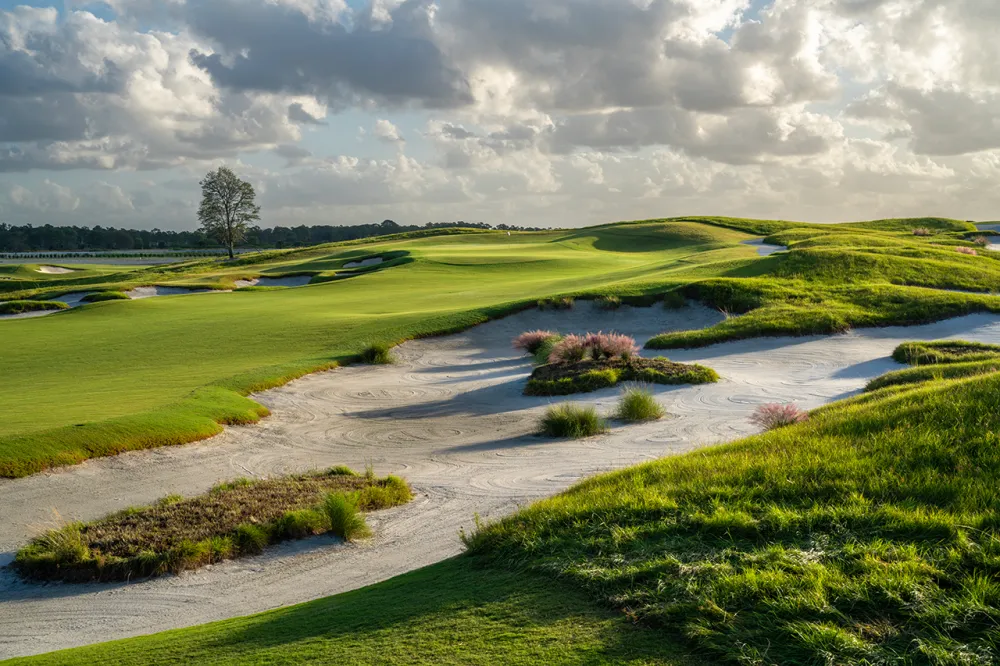Panther National is the first of several planned new openings in south Florida, to accommodate a post-pandemic shift in demand over supply in the area.
This feature was originally published by Golf Course Architecture magazine.
This course at this new private club, in Palm Beach County, is designed by Jack Nicklaus alongside PGA Tour golfer Justin Thomas. The club has been developed by Dominik Senn, founder of investment firm Centaur Holdings.
“The site was a pasture used for grazing cattle,” says Chris Cochran, a senior designer for Nicklaus. “From the beginning, Dominik outlined that he didn’t want a typical south Florida golf course, which tends to be pretty flat and surrounded by homes, small lakes and roads crossing through the property. Therefore, Jack and I routed a core golf course with the home sites separated by large lakes and no road crossings.”

Excavation of lakes and importing of dirt would give the design team the fill they required – around three million cubic yards – to build a course that is by no means flat.
“Creating a lot of elevation change added an extra dimension to the design,” says Cochran. “Significant uphill, downhill and sidehill shots are in play. How the golf ball reacts from these lies greatly determined the placement and types of hazards we used.
“From a playability standpoint, the scale of elevation change provided Jack and me with a more natural way to present a truly effective ground game. More than half of the greens have strong contours to help feed the ball towards the pin.”
There are seven sets of tees: making the layout playable from 4,563 to 7,840 yards (from the ‘JT’ tees).
Almost 30 acres of bahia grass and numerous bunch grass beds have been planted to provide a contrast to the Bimini bermuda fairways and rough. Grassing was completed in August, and the course is opening on 17 November.
“The playing experience will be exceptionally fun and memorable,” says Cochran. “There is a lot of positional strategy off the tee to gain the best angle into a green. There is also a nice balance of doglegs and green angles, what side of the hole water is on, the occasional forced carry, and so on – all of which adds variety to the round.
“What people can’t see from the routing map, but will discover when playing the course, is that variety of lies, and how the wind, hazards, visuals and setup affects each shot.”
There are over 200 home sites at Panther National, all positioned to preserve the core golf experience.
“I have worked on countless golf and residential projects and I cannot think of one where the client was so pro golf,” says Cochran. “Dominik knew how many homes he needed and a good idea of the clubhouse and maintenance area. For the main course Jack and I were given an area to stay within and we developed multiple routings. We would adjust them and sometimes the property lines too, so we could create the routing that works best. The extensive lake system around the course was developed to provide a barrier to the homes, which still have course views.”
The design team has also created a nine-hole par-three course. Earthmoving began in March 2022, with shaping kicking off a month later. Grassing was completed in February 2023.
“For the short layout, the property line was much more set than the main course and there was very little give and take here,” says Cochran. “The configuration isn’t as seamless as I would like but it’s crazy fun to play and an easy walk. The site is relatively flat; it doesn’t have the elevation changes you see on the main course, but it is a really fun layout.
“During one of JT’s visits, he said how he likes the flexibility of playing from anywhere on the short course, not just from the direction of how the holes were routed. We took this into consideration when placing plant material and finalising green contours and bunker placement. JT also talked about how valuable par-three courses are for practicing, especially for dialling in the distances of his wedges and short irons. Therefore, we went with freeform ribbon tees to give the golfer more freedom to choose where to tee from and to spread the wear better.”
The nine-hole layout has 1,101 yards on the scorecard but with the large teeing areas, holes can play much shorter or longer.
“Like the main course, it is lightly planted with trees, but they make a big visual impact,” says Cochran. “The trees, coquina paths and native grasses give the layout more of a garden feel in comparison to the bold, rough-edged main course. For the most part, greens have more contour than on the main course, placing more emphasis on accurate wedge play.”
There are also extensive practice facilities at Panther National, including a 33,000-square-foot putting and chipping green located between the short course’s first tee and ninth green. “It has very flat to strong contours to provide great variety for golfers,” says Cochran.
The main course has two practice putting greens. “The practice green near the first tee is free flowing with long slopes and multiple breaks,” says Cochran. “The Justin and Mike Thomas-inspired practice green near the practice tee is much more structured, it has engineered slopes, ranging from one to four per cent, that are easy to identify.
“Using plenty of input from JT, the short-game area has one large green that can be used from all sides. We worked hard to allow for as many different short-game shots as possible, including those from uphill, downhill, sidehill and flat lies. Although it is mainly for shots up to 50 yards, golfers can hit 100-yard shots from one end of the short-game area to the far end of the green. The putting surface is broken up into two zones – one half is very simply shaped, and the other half is made up of a series of small decks where precision is needed to fly and carry the ball the correct distance.”
The range has been designed to provide what tour professionals are looking for when they practice. There is over two acres of teeing space, target greens to allow players to practice shots from 50 to 225 yards, and there is a 27-yard-wide fairway (the standard fairway width at a US Open) framed by bunkers for players to practice their drives.


